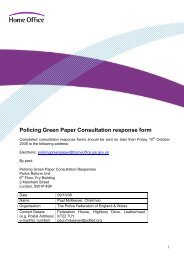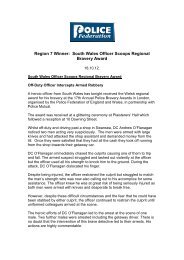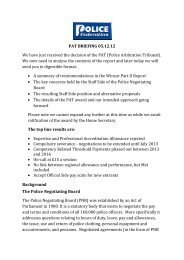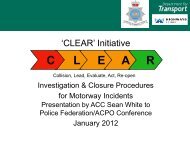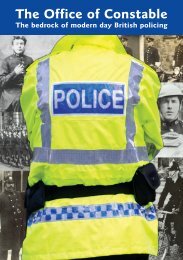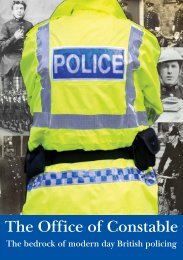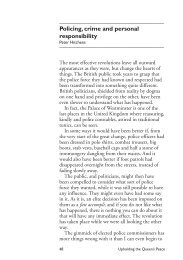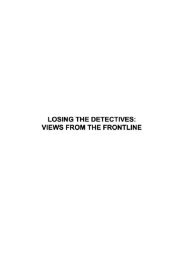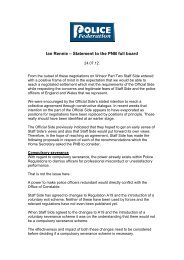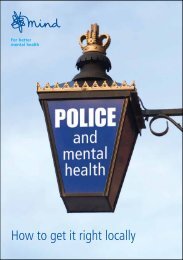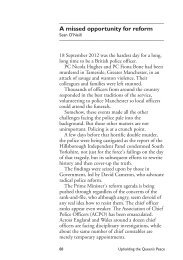Policing UK 2013 - Police Federation
Policing UK 2013 - Police Federation
Policing UK 2013 - Police Federation
You also want an ePaper? Increase the reach of your titles
YUMPU automatically turns print PDFs into web optimized ePapers that Google loves.
THE ROLE OF POLICE<br />
Fire power and<br />
less lethal options<br />
Eran N. Bauer explains<br />
where firearms and use of<br />
force fit in to British policing<br />
Eran N. Bauer is Director<br />
of Civil Defence Supply<br />
This could well be a sterile technical<br />
paper on equipment, tactics and<br />
effectiveness. I personally believe<br />
we should concentrate more on the way<br />
the law internationally, but in particular<br />
English law, dictates what we can and<br />
cannot do with regard to use of force.<br />
The <strong>UK</strong> police is a totally accountable<br />
service, policing by consent. Every officer<br />
has to justify their perception of a threat<br />
and react within set parameters dictated<br />
by rules of engagement and limitations<br />
of reaction.<br />
What sets us aside from other nations<br />
is that our police are fundamentally unarmed<br />
and have to find creative methods<br />
to survive in today’s violent society. This<br />
is one reason why research into and the<br />
adoption of less lethal options such as use<br />
of physical means, the baton, chemical<br />
incapacitants, TASER and 37mm<br />
kinetics have an important place within<br />
our response to threat.<br />
For years, policing disturbances in<br />
Northern Ireland became the proving<br />
ground of many new procedures,<br />
especially as firearms were often used<br />
against the Royal Ulster Constabulary<br />
(RUC) and Army. It took about 30<br />
years for these methods to become<br />
commonplace on the streets of mainland<br />
Britain. Today, the public take little or<br />
no notice of armoured Land Rovers<br />
being deployed, armed police operations,<br />
ranks of police in full personal protective<br />
equipment (PPE), shields, helmets and<br />
batons drawn, even at football matches.<br />
Television coverage on prison riots<br />
such as Strangeways and Risley ran<br />
parallel to publicising the inner-city riots<br />
that followed. Toxteth in Liverpool, St<br />
Paul’s in Bristol, Brixton in London and<br />
Hansworth in Birmingham were the last<br />
major incidents where traditional British<br />
bobbies were seen in their duty uniforms<br />
attempting to quell a serious challenge.<br />
A massive review followed, with reequipment<br />
and re-training including<br />
the creation of the Gold, Silver and<br />
Bronze command structure. Today, most<br />
post-operational debriefs report that<br />
public perception is that public safety<br />
fully justified how and why forces of law<br />
and order were deployed, even though<br />
shops and houses were destroyed and<br />
communities hurt.<br />
Changing threats<br />
Disorder and threats to law and order<br />
are ever changing. What were serious<br />
but isolated incidents, such as random<br />
IRA bombings and the Miners’ Strike,<br />
changed into the global threats of<br />
terrorist atrocities (9-11, 7-7), religious<br />
extremism, regional disorder, increasing<br />
use of firearms and knives in gang<br />
warfare and street disorder. In addition,<br />
rises in drug and alcohol abuse fuelled<br />
by social change such as the recession<br />
encourage criminality and protest.<br />
74 | POLICING <strong>UK</strong>



